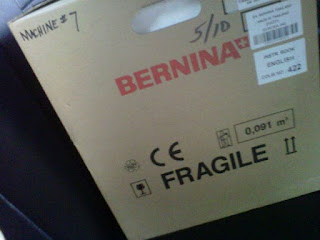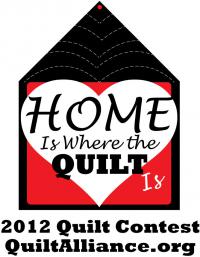I signed up for the Checks and Balances Quilt As You Go class at City Quilter this summer because I do love quilt as you go (it helps improve the odds that I'll actually finish what I start!) and Judy Doenias is one of my favorite teachers (she's also one of the teachers for City Quilter's ongoing Dear Jane class). It was a three-session class that ended last night, and although Judy and one of my quilting pals convinced me to do an entirely different pattern (Tipsy Strips, a variation on Drunkard's Path - see one of Judy's samples here), I paid enough attention to the Checks and Balances pattern to give it a try some time.
I decided to make the quilt as a gift, so once again, I can't post any of my progress yet. But, I'd like to say a bit about the class experience.
Historically, quilting has always been a community activity as well as a solo endeavor. A quilter might piece together a top alone, but would likely call upon friends and community members to help with the quilting. One of the things I like most about the quilting classes I take is the input and feedback from others in the class. Someone might ask a question that I hadn't thought of, or someone might offer an alternative method for cutting or assembling. And of course, there's the invaluable advice on which color to use for the border, or which of two green batiks best compliments a quilt without overwhelming it. Whether or not the advice is taken, I've found that quilters are happy to offer their thoughts and respect whatever choice is made.
In short, I really appreciate the community of the quilting class. Last night was a perfect example. One of the fabrics I chose for the back of my quilt is considerably brighter than the other fabrics. I'd originally made four blocks with each of the six backing fabrics (three each of two different colors) so that I could get an idea of how they would work together. When I laid out the blocks with like fabrics together, I found that the brighter fabric stood out, but not in a good way. After a lot of thought, I'd decided not to make any more blocks with that fabric and to find a fabric that blended better with the others. I like the fabric, so I was a little disappointed, but I knew I'd find a use for it some time down the road. Last night, I put all my blocks up on the design wall in the class room and started bringing in other fabrics to see what I could use in its place. Judy and the other students were very helpful in offering their thoughts on whether or not something worked.
I hadn't been able to find anything I liked and was feeling a little discouraged, when Judy said she really did like the bright fabric, and a few others agreed. I like it too, but it's just so much brighter than the other fabrics that it drew my eye right to it. Then I got an idea. What if I mixed the like colors together, instead of making a path with just one fabric at a time? I rearranged the blocks on the wall...and it worked. Everyone agreed that mixing the colors made the best arrangement.
Done! No need to sideline the bright fabric. No need to buy new fabric. Time and money saved! Without the input from the others at the class (not to mention the spacious design wall), I likely would not have found the right combination and layout.
And that's not to say that the sole focus of the class was my layout. There was teaching, and sharing samples, and we also gave our input to another class member who was looking for just the right combination of batiks for her quilt. Very understated colors, but with a little pop of turquoise. How much more turquoise should she use? What would be too much? Everyone chipped in, but no one seemed offended if their suggestion wasn't chosen.
People may wonder why I take so many classes and spend so much time shopping at quilt stores. Sure, I enjoy learning new techniques and patterns, but I think much of it has to do with the sense of community I feel. Where else will a perfect stranger ask you to help them make a decision on their purchase? I get very strange looks when I ask someone at a department store if something I've tried on looks good, but I've had numerous people ask my advice, or offer advice, on fabric combinations.
And so I offer my thanks to teachers, classmates (I'll miss everyone from the Checks and Balances class and hope to see your finished quilts someday), store employees, and random shoppers for providing me with such a welcoming and supportive community. You all contribute to keeping me addicted to quilting!















